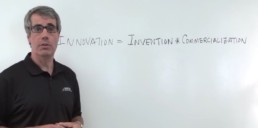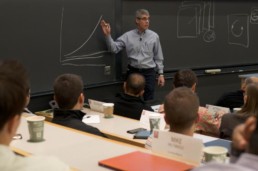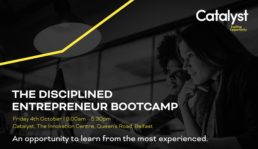The Enemy Isn't Stanford, Harvard, or Berkeley. The Enemy Is People Who Don't Do Entrepreneurship.
Bill Aulet was interviewed on August 23, 2019 by Philip Bouchard, Executive Director of TrustedPeer Entrepreneurship Advisory. This interview was condensed and edited for clarity.
Interview questions and highlights
- What are your three primary roles as an entrepreneurship center director?
- Are the approaches to entrepreneurship and innovation maturing to the extent that standards are being set?
- Are ecosystems the next phase of university entrepreneurship?
- What programs would you encourage directors of emerging ecenters to implement?
- What decisions have you made that you would advise other universities to avoid?
- How can universities enable bigger corporations to become more entrepreneurial?
- How can universities collaborate with big companies?
- What is an “innovation hotbed” and how can a large corporation develop one?
Philip Bouchard: As the Managing Director of the Martin Trust Center for MIT Entrepreneurship, what are your three primary roles?
Bill Aulet: First of all, we are educators. We teach students how to fish, not how to catch a fish. We’re not an economic development agency nor are we an investor. We are focused totally on the student and that’s the number one thing that we need to understand. There are other people who are investors. There are economic development agencies, but our job is to teach skills, to teach people how to fish, and that’s how we should get measured.
The second thing is that entrepreneurship is not a science nor is it an art; it’s a craft. As such, we need to teach students how to do something that creates a unique product that no one’s ever created before. Students can be taught their first principles to do that, but they don’t guarantee success. Entrepreneurship must also be taught in an apprenticeship model.
It’s important that we understand our mission, to understand the nature of the task in front of us and to approach it with both a serious element of being evidence-based, looking for data and being rigorous about it. We need to approach entrepreneurship with a sense of humor so that we don’t take ourselves too seriously because this is an area that’s fraught with failures as you’re running your experiments.
In summary:
- First, we’re educators.
- Second, we have to understand what is the nature of entrepreneurship education. It’s a craft. It’s not a science. It’s not an art.
- Third, we need to do that with rigor, but we also need to do it in an environment that allows people to experiment, fail and learn from that.
PB: The languages of Disciplined Entrepreneurship, Lean Startup and Business Model Canvas are broadly accepted. Are the approaches to entrepreneurship and innovation maturing to the extent that standards are being set?
BA: Not as not as much as they should be. I’m concerned that entrepreneurship is not seen as a serious body of knowledge, as a serious field. Currently, what we are seeing is often the term of the month? Is it Lean or is it Crossing the Chasm? Is it this? Is it that? These things are propagated by people who write popular books. They’re not done by serious academics. I don’t mean that in any negative way towards the people who do those things. I just mean it in a sense that, for example, medicine is not going to be taught and practiced off some popular book that comes out. Entrepreneurship has to be driven by an academic, be evidence based, and with rigor that’s reviewed by other people who do that.
While things have improved, we’re a long ways from entrepreneurship being a respected field of study by academics, by practitioners and by the students themselves.
PB: You have said, “The one necessary and sufficient condition for an ecosystem is entrepreneurs. The essence of a healthy ecosystem is better trained entrepreneurs who are more connected.” Are ecosystems the next phase of university entrepreneurship?
BA: That’s a really good question. When we’re teaching entrepreneurship at MIT, when I first started 10 years ago, the persona that we were expected to focus on was the ready-to-go entrepreneur. An example of that persona was Chris Nolte who was going to start a company. That was our target market and that’s what we built our product towards, that is, our classes, our extracurricular and co-curricular programs and our competitions. We’ve done a good job but that does not represent the interests of all the people that we get in our classroom. That represents 10 to 15%.
The biggest portion of people who are curious entrepreneurs, exploratory entrepreneurs who make up 50% of our class. We need to attract those people, to say to them, “This is what entrepreneurship is. Not to become an extra in Silicon Valley the TV show”. Entrepreneurship is a much broader field than that.
We’ve got ready-to-go entrepreneurs and we’ve got curious entrepreneurs. Curious exploratory entrepreneurs are not a steady state category; they’re going to become ready-to-go entrepreneurs or they’re going to become the persona that we call joiners. Joiners want to be entrepreneurs but they’re not ready to be the first person in a company. They don’t want to be a founder. They want to join a company. Someday they may become the founder. That is a legitimate group of people who we consider entrepreneurs. Also, there are corporate entrepreneurs.
But there’s another category that we didn’t expect. We call these people entrepreneurship amplifiers. Amplifiers are people who are not starting companies, but are enabling environments where people can thrive. An example of this persona was Esteban Lipinski. He was not going to start a company; he was going to take over the family business, but he wanted to be able to get people who are going to be corporate entrepreneurs into his organization. He wanted to be able to work externally under the concept of open innovation with entrepreneurs who were out there doing their startup thing. Esteban Lipinski was such an ecosystem person.
We found that a lot of those people moved on to help develop entrepreneurial ecosystems in government, in the private sector, in corporations and elsewhere. “Ecosystems” has now become an incredibly big buzzword. Ecosystem has a lot to do with policy and what corporations do with their risk capital.
All those things are important but sometimes people lose focus. The single necessary and sufficient condition for business is a paying customer. You should always have your customer at the center of your thought process, of what you’re doing and of your programs.
For an ecosystem, it’s all about getting entrepreneurs, getting more of them of higher quality and having them more connected because that’s how you will create a vibrant entrepreneurial environment or ecosystem.
It is a complicated system with all these parts and stakeholders contributing to it. It’s important that we put entrepreneurs at the center and understand that, not only do we need entrepreneurs, but we need to “up level” them, we need to connect them together and we need to create more of them. Then you’ll be able to have a successful entrepreneurial ecosystem.
PB: For directors of emerging entrepreneurship centers, what programs would you encourage them to implement?
BA: If you’re going to start a hospital in a rural area, you don’t try to recreate the entire field of medicine. You should take all the things that already work, bring them in, use those and customize them to your environment.
Figure out what makes you unique in your school, in our region, in your mission as a school entrepreneurship center. Once you have done that, look at all of the material that’s available. As you may know, MIT makes all of our materials open sourced, available to anyone. MIT provides all of the slides, quizzes, syllabus and videos; whatever you’d like. Take those materials and customize them. Then connect back to this educational community to get feedback on what you’re doing.
As we always say to a start-up, “Stealthy is unhealthy.” If you have an idea you should socialize it with other people. Likewise, if you are an educator, if I have something that’s good, I will gain by sharing it with other people, by getting their feedback and by getting their updates. As educators we’re in the field of producing knowledge that will positively impact the world. We’re in the business of helping to create the next generation of entrepreneurs. We shouldn’t let proprietary egos get in the way of this. We’re not in this for the money. We’re in this to help make the world a better place.
Use what’s out there already. But, before you do that, figure out what is it that is unique about your environment. Take what’s already out there and then have the group give you feedback about how they’re using it. The strength of the pack is in the wolf. Each wolf should be strong in the pack, but the strength of the wolf is in the pack. Meaning that the wolf is much stronger if it’s part of a pack.
We, as entrepreneurship educators, should all work together and we will all benefit from that dramatically. We should have our own “entrepreneurship pack” where we all make contributions and we all give back.
PB: Can you share any decisions that the Martin Trust Center has made that you would advise other universities to avoid.
BA: We have made so many mistakes but those mistakes are not something that we dwell on. We have a development program where we constantly rotate our entrepreneurs-in-residence. I’ve been at the Martin Trust Center for 10 years; I’m the backplane but we’re constantly rotating people because we want to stay current. It is not productive for me to speak with young entrepreneurs about what it was like to work with mainframes and enterprise software. We need to have a dynamic crew of people coming through to keep up with what’s going on.
We also have what we call our “honest broker policy”. That is, we should not be an investor. Let investors invest. Educators make poor investors; investors make poor educators. Play your position. If I’m a goalie in soccer then I should be the best goalie in the world. I shouldn’t be trying to score goals at the other end of the field. If you are Lionel Messi and you are a great goal scorer, don’t try to act like you’re a goalie; play your position. Michael Jordan was a great basketball player. When he tried to play baseball, it didn’t work out so well.
Let’s just be the best educators we can; let’s not get into investing at an organizational level or at a personal level. Even though we can make money, it’s not the right thing. So many benefits that accrue to taking that position because a student never has the perception that you’re out for something other than their own self-interest. They understand that you’re worrying about the “fish that they catch” because you have a financial incentive; that you’re not trying to get yourself a job or a job for some friend of yours. Leave that to the students to make all those decisions; don’t leave any ambiguity.
I wrote a piece called The Brilliance at 100%. When you are a 100% educator, there’s no ambiguity as to whether you are 5% of the time as an investor. Let’s be 100% educators. Let’s keep it simple.
PB: You have said, “Many of our problems in society like healthcare, energy and environment are longer-term problems. We as a society need big companies to become more entrepreneurial. The solution is a concerted effort to foster entrepreneurial thinking. It is important for society that we develop this field of corporate entrepreneurship so that bigger corporations can become more entrepreneurial.” How can universities enable bigger corporations to become more entrepreneurial?
BA: This is one of the big challenges. I enjoy startup entrepreneurship more than I enjoy corporate entrepreneurship. I worked at IBM for 11 years. I know what it’s like. There’s a movie called Silicon Cowboys about this and I’m in it. Corporate entrepreneurship is a lot harder than startup entrepreneurship. It’s not as much fun as startup entrepreneurship. When you are a startup entrepreneur, you got this beautiful clean slate and you can do whatever you want with it. When you’re in a corporation, the canvas is already there and you only get to do some small part. It’s just a lot harder and is more of a grind at a political and at a personal level.
It’s essential that we understand that startup entrepreneurship is just going to get the low hanging fruit. To do some of those bigger things like healthcare and energy, we need organizations that have assets and balance sheets. We need to get them to be more innovative. Entrepreneurial behavior and innovation has been much more prevalent in startups than at big companies. We can’t just accept that; we have to get that to change.
To that end, we are teaching people how to have an entrepreneurial mindset to be different. In a big corporation you are taught to optimize, to de-risk, to make things predictable. That’s what management is. What we’re doing is creating new things which requires a different mindset. But it’s not just the mindset, it’s a skill set. We’re teaching them with, for example, the Disciplined Entrepreneurship approach, teaching them finance, teaching them the basics. You’ve got to have the heart to be an entrepreneur, you have to have the head to know what to do with these principles, and you have the hands to be able to do it.
The last “H” should we talk about is the is the home. How do you create these communities where you can work in a much more efficient way than you’re taught in a big corporation? When I worked at IBM, they said, “Bill, here are your resources to work on this PC project. And Phil over there is the best embedded coder of them all. When Phil doesn’t want to work on the project, he doesn’t exist to us anymore.” We learned that we must own all the resources, control them and then execute in an efficient way. That approach doesn’t work anymore today.
Today, what entrepreneurs have learned is how to work with resources beyond their control. Professor Howard Stevenson defined entrepreneurship as a pursuit of opportunities with resources beyond your control. We teach our students how to be different, how to do it from the fundamentals of market segmentation, total addressable market, building a persona, cost of customer acquisition, all those basic fundamental things. Then we have to teach them how to operate in communities with this efficient distributed operational model.
If you teach the four H’s – Heart, Head, Hands and Home – those people can go into big corporations and they can produce what we call “antibodies”. They are people who, in the face of chaos, in the face of change, in the face of adversity, don’t just survive; they see it as an opportunity and they get stronger. That’s what we’re focused on.
I have an article coming out on the goal of entrepreneurship is to produce anti-fragile human beings.
PB: You’ve also said, “Don’t look at big companies as the enemy; look at them as someone you can collaborate with.” How can universities collaborate with big companies?
BA: Corporations want their problems to be at the focus of student projects. There’s a balance here because I could spend all our time working with corporations, but that is only part of the portfolio of things I should do. I should be working on the startup individual. I should be working on the joiner. I should be working in the corporate entrepreneur. I should also be working on the new entrepreneurship amplifier persona that we’ve talked about.
We have a corporate members program where we don’t take an enormous amount of money from them to be members, but we take enough to get them engaged for an ongoing dialogue. That dialogue is around getting exposure to talent, getting exposure to ideas, taking challenges that they might have and putting them in front of students to see how they might work. This is done in classroom projects called action learning and in extra-curricular programs.
Corporate members also like to – it’s very beneficial for them – sponsor competitions because they get a view into students and get to see what a different culture is like than the culture inside their four walls with mahogany and cubicles and an environment built on efficiency and optimization.
PB: In an MIT blog post, you stated that, “While entrepreneurship can be taught, what is more important is the “innovation hotbed” where entrepreneurs and intrapreneurs, those who are entrepreneurs within established large corporations, develop their skills.” What is an “innovation hotbed” and how can a large corporation develop one?
BA: The word “ecosystem” has become one of these cliche words like “disruptive” and “innovation”. I don’t really know what it means.
What I mean by hotbeds is community. When you walk into the Martin Trust Center for MIT Entrepreneurship, it feels different. People are doing all these different things. There are signs up that say, “It’s more fun to be a pirate than to join the Navy.”
A hotbed is a community of things that are happening. Think of it as Greenwich Village in the in the 1960s; think of it as Williamsburg in Brooklyn today. It’s a place where you go, with lots of ideas and people being different and exploring different things. Not only is it acceptable to be different and innovative and trying new things but it’s cherished. That’s what you’re pushed to do. In his book Influence: The Psychology of Persuasion, Robert Chaldini states that people are more motivated, not by the economic side of it, but by peer influences. Having communities allows people to open up.
For example, no one in my family was entrepreneurial. We didn’t even know what the word “entrepreneur” was. I went to college and I didn’t know what it was. It wasn’t till I got an exposure to it in a community. Mitch Kapor was at Lotus Development Corporation when I worked at IBM. All of a sudden a world of possibilities opened up.
The data is clear. Entrepreneurship is not nature; it’s nurture. And nurture is about being put in an environment to see what’s possible. If other people are doing it, then you keep up with them.
The analogy I would use in sports is look at the Dominican Republic which is amazing for baseball players. Lithuania is amazing for basketball players. Is there something genetically in those countries? No, because you can see places like Romania when Nadia Comaneci became a fantastic gymnast, the fact that there was a role model and people talking about gymnastics and doing it with their friends that all of a sudden Romanian gymnasts stormed the world. Was there some special muscle that they had? No! It was about role models.
This idea of the power of influence and the communities – hotbeds – is important for people to understand. That’s what we do at the Martin Trust Center. We provide that home. I talked earlier about the heart, the head, the hand and this home. It is hard to measure but it’s really, really important.
I would encourage all the entrepreneurship instructors out there to understand that you’ve got to create these communities. That’s the part about networking people together. That’s the magic that happens in places like Cambridge, Massachusetts or Silicon Valley or Boulder Colorado right now or Israel. They are talking to other people and then the whole group moves forward
PB: thank you so very much. This is an incredible interview and I look forward to publishing it.
BA: Thank you very much for having me, Philip, and good luck with what you’re doing. It’s a noble cause; we need to connect the entrepreneurship educators together. We all need to be pushing to help each other. As I always say to my good friend Tom Byers, “The enemy isn’t Stanford. The enemy isn’t Harvard. The enemy isn’t Berkeley. The enemy is people who don’t do entrepreneurship.” We’re all part of the same fraternity. We should all help each other. That’s why I love what you’re doing.
The author
Bill Aulet
A longtime successful entrepreneur, Bill is the Managing Director of the Martin Trust Center for MIT Entrepreneurship and Professor of the Practice at the MIT Sloan School of Management. He is changing the way entrepreneurship is understood, taught, and practiced around the world.

The Disciplined Entrepreneurship Toolbox
Stay ahead by using the 24 steps together with your team, mentors, and investors.
The books
This methodology with 24 steps and 15 tactics was created at MIT to help you translate your technology or idea into innovative new products. The books were designed for first-time and repeat entrepreneurs so that they can build great ventures.
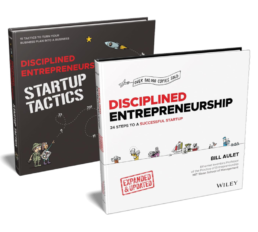
"That Will Never Work: The Birth of Netflix and the Amazing Life of an Idea"—24 Reasons Why I Love This Book
A few weeks ago, I had the good fortune to get an early release of the book That Will Never Work: The Birth of Netflix and the Amazing Life of an Idea by Marc Randolph. Marc and I grew up about 2 miles away from each other and went to the same high school. He was a very good guy and while we were friends, by the time high school arrived and after, we traveled in different circles. I had heard he was a co-founder of Netflix but it was hard for me to visualize how that happened and while curious, I certainly did not know the story. He had done all of this on the West Coast. When I heard he was coming out with book about his experience, I was intrigued. When I sat down and read the prerelease copy not only did I like it, I was blown away. It is fantastic.
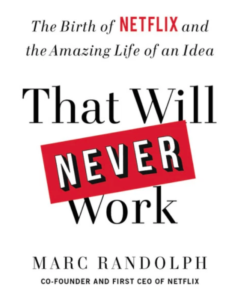 I found it to be not just honest and super authentic but also intelligent in how it described the right way to think about entrepreneurship (without all the pomposity – that did not go down very well in our neighborhood). Plus, it was extremely readable. Using the power of the narrative and sublimating his ego, Marc was able to tell the story the way it really happened rather than rewriting it to make himself seem like a superhero. As a result, I found it very helpful as an educational book … but it is also so entertaining and fun to read. I kept thinking of the word “binge reading” while I was reading it as I found it hard to put the book down.
I found it to be not just honest and super authentic but also intelligent in how it described the right way to think about entrepreneurship (without all the pomposity – that did not go down very well in our neighborhood). Plus, it was extremely readable. Using the power of the narrative and sublimating his ego, Marc was able to tell the story the way it really happened rather than rewriting it to make himself seem like a superhero. As a result, I found it very helpful as an educational book … but it is also so entertaining and fun to read. I kept thinking of the word “binge reading” while I was reading it as I found it hard to put the book down.
There are so many great points and as I went through, I found myself using the Disciplined Entrepreneurship Canvas to check off the problems the team was solving as they took Netflix from an idea to a juggernaut.
Rather than claim that there is a singular insight to making a successful entrepreneurs, it is clear that it is a complex system and getting many things right in balance and at the right time – and not getting the things wrong that will kill you – is the real key to success. It is not simple but it also has to be manageable and you must be systematic about it.
As such, I am going to highlight 24 reasons (consistent with the 24 step theme) of why I found this book so insightful and a must read for entrepreneurs looking to up level their game.
24 Reasons Why I Loved This Book
- Raison d’être: It was not clear from the book to me what the exact the “raison d’être” or driving vision why the world would be such a better place because of Netflix but there was something special in the air. They got people to work there for less money and work relentlessly through difficult problems. They made it about much more than the money. They got people who bought into their entertainment mission … with both feet in.
- Focus, Focus, Focus: There are really two underlying themes above all else in this book that come through loud and clear – and should. Focus and culture. They are not different swim lanes from the rest of the business but rather integrate into everything. Focus is how they survived and, in the end, thrived. At one point, Marc refers to focus as the secret weapon of entrepreneurs. I like that. When he talks about the necessity of focus, he writes “At a startup, it hard enough to get a single thing right, much less a whole bunch of things. Focus is imperative. Even when the thing you’re focusing on seems impossible. Especially then.”
- Culture Eats Strategy for Breakfast: Marc owns from the very beginning that Netflix legendary culture (there are 19 million views of their culture deck on SlideShare) is fundamental to its success (and not necessarily for everyone). He describes how it got started and how their Chief People Officer, Patty McCord, got pulled in to central core of the founding team very early. They also were very thoughtful and intentional about how they made sure their culture could scale. I won’t repeat what I have written elsewhere on this subject but merely say that Dharmesh Shah has it right when he says that enduring companies thoughtfully build two products: (1) A product for its customers, AND (2) A product for its people (i.e. culture). There are great insights on how this happened by design and then grew via continued commitment.
- The Original Idea Doesn’t Matter That Much: As I have mentioned in The Most Overrated Thing in Entrepreneurship article, this book brings the point home in spades with some great caveats (see next point). The original idea needed to morph extensively and there were probably lots of people with the same or similar idea to make an online movie store but Netflix jumped in and figured out the details and executed. That is what matters.
- However, There are Bad Ideas; You Just Don’t Know Until You Test Them: A key mantra of Marc, especially at the end is that “Nobody Knows Anything”. Sometimes this is taken too far for my tastes but the author’s point is that nobody knows if something is a good or bad idea until it is tested. The name of the book is “That Will Never Work” because that is what Marc’s wife told him about the Netflix idea. In fact, it would not have worked as originally envisioned but after experimentation and implementation, it was clear what would NOT work and then adjustments were made to find something that did work. When the experiments and data show that it is not a good idea, then it is a bad idea and this must be acknowledged and appropriate subsequent actions taken.
- Entrepreneurship is a Team Sport: To succeed you need to have a team with a of diverse team members – common vision, shared values, and complementary skills. It is so interesting to hear how he built the team that not only succeeded but scaled a pretty good distance. Of course, the intense relationship with Marc and Reed is gripping reading as well but it is not the only key relationship at all. This was truly a team with a common vision and complementary skills.
- Luck is When Opportunity Meets Preparation: Disruption is overused term but Marc and Reed looked for an opportunity where there would be a market dislocation in the future. Online stores, video viewing, DVDs, constant consumption – a convergence of these was destined to happen in the not too distant future. The Netflix team got to work and were fully committed to lead in this space. They arrived ready before anyone else so when the opportunity finally arrived, because they had their “10,000 hours of preparation” under their belts to seize the moment.
- Super Valuable Tests Can be Very Simple & Low Cost: One of the turning points in the story is when Marc mailed a CD in the US Postal Service normal mail delivery to see if would be successfully delivered without damage or significant costs. This was a key hypothesis and easy to test. It worked. This shows that simple, low cost tests can be done to validate key assumptions and they are better than debating competitions.
- What is Your Core? It is great if you can create value for a customer but you have to think multiple moves a head strategically. You don’t want to incur the expense and effort of creating a market only to have someone else (Amazon?) comes in and reap the rewards of this new market and leave you on the sidelines. If Netflix did not think strategically, this would surely have happened. The story shows how they were constantly anticipating and working this intellectual challenge very hard issue even when it ran counter to their short term interests. Their strategic instincts were excellent.
- What are Your Moats to Develop Your Core? Along the way, to develop their core (a rental business), but that was not enough. There are were a lot of other things they had to excel into for survival. We call these moats but you can also think of them as necessary capabilities which offer short term competitive advantage. Logistics? They needed to be excellent (and they were) but they knew this was not sufficient to beat Amazon and others. It would not be their core. Comprehensive Library? An excellent short term special feature but again, but not a long term defensible core. Reviews? They must also be excellent in this dimension of allowing people to create them and developing a community but it alone would not be a sufficient to be a defensible core.
- DVD Sales = The Volvo: In my courses and videos, I usually start with the Lamborghini and Volvo story forcing the class to make a choice. Do you get distracted and take a customer who has cash and wants you to service her Volvo? People often over simplify that lesson and say you should never take the Volvo. Not true. Sometimes you have to take the Volvo to stay alive for another day but you must understand it is temporary and potentially very distracting short term solution. You have to know it is not a long term strategy and wean yourself off this bad drug as soon as possible. You must have a long term strategy and just use the Volvo, very, very carefully if necessary, as a bridge.
- Window of Opportunity and Triggers: In the DE Workbook, I have a whole chapter on Windows of Opportunities (WoO) and Triggers. Without knowing those words, Netflix realized that they had a WoO when a consumer bought their DVD hardware. They smartly designed a trigger (a marketing campaign and give away) within that Window of Opportunity to capture a customer that would be very difficult to reach otherwise. They had to work hard but they were able to partner with the major (at that time) DVD hardware manufacturers and partners – Sony, Toshiba, Panasonic – that got them their initial lift.
- CoCA/CAC to LTV Ratio: Again, back to the DE Canvas systems model, once they had figured out who their customer was, how they could produce value, especially uniquely in the long term, and they were starting to get traction in the market, the big question is, “do the unit economics work?” As Reed says so bluntly on page 156, “It’s like a taxi driving all the way to another state just to pick up a four-dollar fare.” Wow, that pretty well captures the essence of unbalance unit economics from a misaligned CAC/LTV ratio. They do get it fixed but first you have to define the problem and have people really understand the issue.
- Relentlessly Focused to Get to Rentals and Not be Satisfied with the Volvo (DVD Sales): To the point above (#11) about have had the strategic insight to know that they would never beat Amazon if they stuck with DVD sales, you still have to admire their execution. They showed extraordinary intestinal fortitude to get out at the right time and in the right way. This required enormous discipline because it is very hard to give up a cash cow today. But they stuck with it.
- Ultimately a Business Model and Process Innovation Solves the Riddle: It is ironic that the breakthrough for Netflix was not a technology or a marketing innovation, it was a business model and process innovation. They had thought of themselves as a store and that created limitations in their mental models for solutions (e.g., they carried the inventory like a store). When force to deal with this impossible problem of creating a rental base of customer with a customer base that was conditioned by the Blockbuster brick and mortar model, it took something very creative. Essentially, Netflix had to change customer habits – not something easy at all. (See book The Power of Habits by Charles Duhigg.) Ultimately, it was a combination of three elements (see page 206-207): (1) Home Rental Library (with no late fees) of Four DVDs, (2) Serialized Delivery from a Customized List, (3) Subscription Business Model. It was this completely disruptive approach that finally got Netflix to achieve its goal of being a movie rental company for the first time. It is interesting to note that technology is not always the answer and often is not the best answer when it is.
- Impressed that Marc and Reed Had the Guts, Smarts and Attitude to Dance with Amazon and Blockbuster – And Come Out Stronger: Some of the most interesting parts of the book are the dances Netflix had with Amazon and Blockbuster when they could easily have been crushed and how they came out better afterwards. I have to say, in my businesses, I steered clear of these meetings and I generally advise others to do so as well until they have some leverage. The fearlessness of Marc and Reed to do this, and how they came out stronger afterwards, is inspirational but I am not sure how to duplicate. They are truly anti-fragile people and they made Netflix in that image as well. Kudos to them.
- You Have to Keep Doing Your PMR (Primary Market Research): Netflix was never satisfied to stand still and they knew the consumer was not going to either. That was what created the opportunity in the market for them to displace the immensely bigger Blockbuster company. It is fascinating to read in the book how they are constantly trying learn what they don’t know (remember “nobody knows anything”) through testing. They systematically studied the consumer behavior (habits) on an ongoing basis by continually running experiments
- Surprise! Next Day Delivery Slightly Improves Churn but the Real Value is Bringing Down CAC and Driving Market Penetration: On page 219 and 220 there is a discussion of how Netflix experimented to see the effect of next day delivery. They felt it would have a very positive impact on customer retention but when they ran the experiment, they were confused. They did not see an appreciable improvement in reducing churn for their customers. Then they realized that they were looking at the wrong metric for success for this experiment. They saw that while churn was slightly materially affected, new signups were surging! The program was creating happier customers (essentially, a higher NPS – Net Promoter Score) which created much stronger advocates for their offering in the community which brought down CAC. The geographic concentration and focus on next day delivery allowed them to improve unit economics and dramatically drive up market penetration. Lesson: You have to measure the right things in your experiments and be open to surprises.
- The Canada Principle: This is directly related to the focus theme mentioned in #2 above that permeates the whole story but it is still worthy of its own point for the clarity it provides with a specific example. On page 216, expansion into Canada was considered and it seemed like an easy victory to pick up for Netflix. It would be undemanding to expand there from the US and Netflix would have gotten an instant revenue increase of approximately 10%. Being disciplined and analytic, they did not do it for two reasons. First, it would be more complicated upon a clear minded analysis with currency exchanges, languages differences (they speak French in Quebec) and other logistical and cultural issues. Secondly, the opportunity cost was high. To quote Marc, “If we took the amount of effort, manpower and mind-power Canada expansion would require and applied it to other aspects of the business, we’d eventually get a far greater return than 10 percent.” This phrase (“The Canada Principle”) became one of the mantras and an explicit example for the company of keeping focus. It became a touchstone story to create guard rails when other projects had to be killed that were not the “main thing” (i.e., core business). Having a clear illustrative story like this has power much like urban legends do (see book Made to Stick by Chip and Dan Heath) has real value.
- Scaling is Hard and Often Involves Two Steps Forward and One Step Back: Even as Netflix began to succeed and move toward an IPO, that failed the first time, you can see the challenges. With success, there are more resources and new reasons to get distracted. It is very interesting and common how Netflix essentially over expanded and then had to contract again to back to becoming a high performance company again. This is brilliantly described, starting on page 255, where they have to hit the brakes and then ruthlessly start cutting programs and people that were not laser like focused on the core business. Again, the rich and very specific description of this is powerful as it the metaphor of “scraping barnacles off the hull”. Focus is not just essential at the beginning but also to create profitable and sustainable growth.
- Two Dreams in Conflict: On of the most powerful points in the book is around the personal narrative when Marc talks openly about the pressure for him to step down as CEO. He has to sublimate his ego and then intellectually realizes there were two dreams at play in this situation. First was the dream of the company and secondly was his dream running it. These two can by full aligned but as the company grows, it is increasing unlikely they will stay full aligned and then there have to be tradeoffs. For great companies, the team dream must come before the individual dream, obviously, but to start a company successfully takes a significant personal ego by a small number of individuals (called founders). You must take it personally to be great. If you don’t, you will not be as successful as someone who does. Ultimately, as Marc explains on page 185-189, he comes to peace with stepping down as the CEO and teaming with Reed Hastings. It all sounds so logical but I can assure you from having been in this situation and seen many others, it is not simply logical. It is extremely emotional. It takes immense personal maturity but it does start with logic.
- Take the Business Very Seriously, But Don’t Take Yourself Too Seriously: Not only for the decision in item #21 above, but also throughout the book as Marc jokes around with others and is able to honestly assess himself. It is yet another example of where you see how important it is for an entrepreneur to use humor, self-effacement and general empathy to be successful.
- Managing People – Freedom and Responsibility: I love specific examples to illustrate fundamental truths and there is a gem on page 195. Marc talks in many places about the principals of effectively managing and motivating people with a fundamental guiding principal of freedom and responsibility. The example is an engineering manager who asks if he can reduce his hours to support a budding relationship – by increasing his remote work time while still managing a group. Rather than paraphrase, here is the excerpt:
“I don’t care where you work, or what hours you work. Work from Mars, for all I care. If all you’re asking me is about when you work and where you do it, that is an easy answer: it makes no difference to me.” He then continued, “But if what your really asking me is whether I’m willing to lower my expectations for you and your group so that you can spend time with your girlfriend? Well that answer is an easy answer too. No.”
Well said. As a good leader/manager, you give people direction but don’t tell them how to do the job but also set high expectations and communicate their accountability to the group. It is then their job to execute against this. It is your job as the leader to protect, resource appropriately, reward and hold accountable your people.
- What really is success?: I won’t ruin the book’s final scene, but let me just say that Marc and his son experience success in the most subtle (and New York City) way. It is not about money. Success is something much more. Money is not the way to keep score.
I could go on and on but you get a sense of the value of the book. It is a rare, honest, entertaining and educational look at what getting a high quality startup off the ground is like. Data shows that the more times you do entrepreneurship (like many other things), the better you get. This is a chance for you to get another experience in a few days (if you binge read) and you will be better off for it.
The book is available immediately for pre-order and starts shipping September 17, 2019 at the latest. It will be available in all kinds of formats and languages.
The author
Bill Aulet
A longtime successful entrepreneur, Bill is the Managing Director of the Martin Trust Center for MIT Entrepreneurship and Professor of the Practice at the MIT Sloan School of Management. He is changing the way entrepreneurship is understood, taught, and practiced around the world.

The Disciplined Entrepreneurship Toolbox
Stay ahead by using the 24 steps together with your team, mentors, and investors.
The books
This methodology with 24 steps and 15 tactics was created at MIT to help you translate your technology or idea into innovative new products. The books were designed for first-time and repeat entrepreneurs so that they can build great ventures.

One Thing That Will Kill a New Company: Tree House Mentalities
This past week reminded me yet again of a common pattern in new ventures that is one of the most common killers of new ventures even if they get the 24 steps done well. It is what I call the “tree house mentality”.
I call it this because I remember when we were young and growing up, we would build tree houses—which generally were platforms in trees. They could be more elaborate with walls and open windows and maybe even a roof. You had to climb to get to them but once you got to them, you felt like you were in a world you controlled. It was super cool especially when you invited some friends… you felt like a king!
Well despite the fact that this is much more difficult to do today because of societal norms and pace, the metaphor has never left me.
In a tree house, in part because of the IKEA effect, you naturally felt like your tree house was in some ways superior to others. In a short period of time, it seemed like destiny that you were emotionally going to war with others in a different tree house because somehow you were superior. You would talk down about people in another tree house. People in your tree house would agree with each other and reinforce our opinions until those opinions became facts in our minds. It was so great and we felt so righteous.
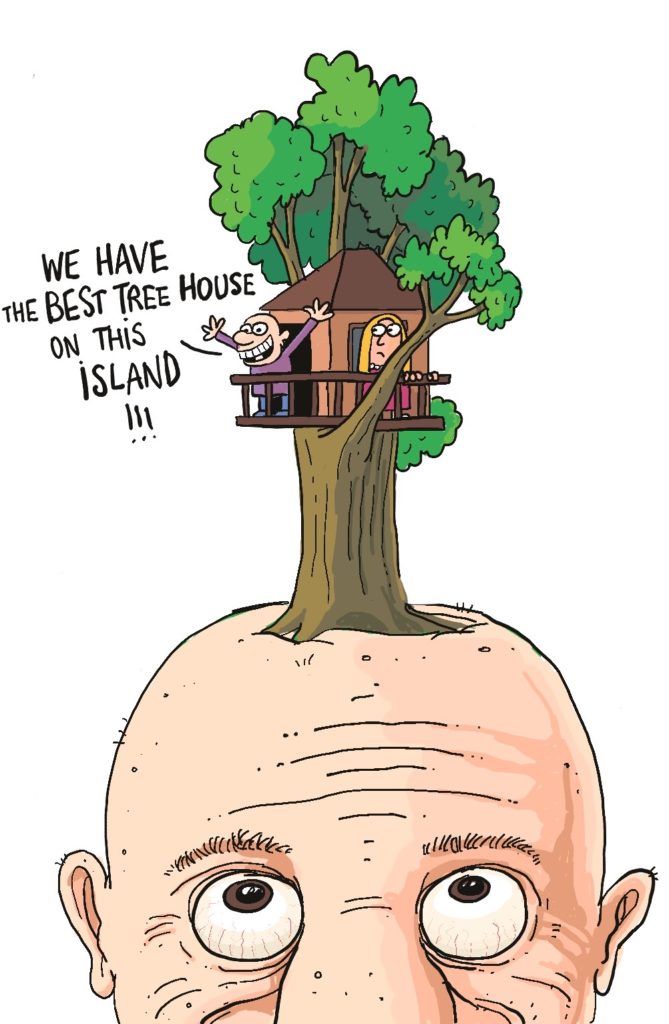
The problem was when we came down from our tree house and dealt with others. Things were not as clear in others’ minds and they were not prone to be as quickly true believers. Even worse, there were other tree houses in which people were saying bad things about us and looking down on us. They thought we were inferior or evil in some type of unimaginable (to us) way. They would whip themselves into a near frenzy by from repeating unflattering things about us and our world view with no dialogue with us.
As I matured and thought more rationally (with some distance in time) about these possibly even well-meaning but ultimately nefarious situations, I saw the pattern. I came to see that much of what we were doing was the equivalent of “gossiping”.
The “tree house” mentality, whether tree houses were involved or not, was something that felt very good while doing it but I saw the end result was almost always not productive and certainly not inclusive. It was very destructive and hard to stop once it started.
Today, this modality dominates US politics. It is appropriately called “tribalism” by some. This is where the right-wing people watch Fox News. This group speaks badly about people not in their tribe, or proverbially “tree house”. Likewise, for the liberals, who watch MSNBC, it is the counter tree house. They talk about how incorrect the Fox News “facts” are and then how terrible people in the Fox News tribe are.
Confirmation bias and reinforcement of beliefs run rampant. Emotions get higher and positions become more intransigent. People on each side are unwilling to back down or even listen to another point of view.
I want to scream often, “Damn it, get out of your tree houses and come down and talk to each other!!! Find some common ground and build off it.”
Unfortunately, I see this tree house scenario happening in companies all the time and it kills them. It is perfectly understandable as we are all humans at the end of the day. We get frustrated and like to get a sympathetic sounding board for our grievances. Founders or executives are no different and they form some of the most emotional tribes. They start innocuously talking with others to see if their perspective is valid. Soon this grows until you have warring tribes. Intentions may or may not start out well-meaning but soon things escalate to a point of no return.
To be an entrepreneurial leader, you must know the threat of the “tree house” mentality, you must take steps to make sure it does not form and if it does, deal with it constructively and quickly.
Up to this point, I have described what this threat is and how destructive it can be. The steps to make sure it does not happen start at hiring, and then you have to be vigilant frequently thereafter. When I hire someone, I tell them that I will support them very strongly so s/he can do their job and advance their career … until such time as they start acting against the interests of the group. Then I will be their worst nightmare. The interests of the group are paramount.
Even so, grievances do arise and then they do, they must be dealt with in an open and constructive way. If someone on the team feels that something can be done to improve the collective team, then they have full support to raise the issue and it (and they) will be treated with respect in the process. It is important that they not just come forward with a grievance but also they should propose a solution to be discussed.
In fact, the team member who does this should be commended and rewarded for being creative in identifying opportunities for improvement and proposing (and hopefully implementing) new solutions. What will not be rewarded is simply complaining. Everyone must be productive. No whining. Secrecy is also not acceptable. Gossiping and political behavior is also rejected.
This can be hard for humans as this bad behavior comes naturally in social situations but as a leader, you must consistently and openly reject it in yourself and others. It can be uncomfortable at times as people are trying to be friendly to you or think they are providing you with important information but the job of a leader is not to be everyone’s friend. Your job is to be respected which is different. Recognizing tree house mentality, clear messaging that it is unacceptable from the start and then crushing it once it invariably shows it heads despite your best efforts – will generate the respect of the most valuable kind. If not, it will be a cancer that has a good chance to ultimately undermine all your other efforts so it is imperative to be a great entrepreneurial leader.
Get people out of their tree houses and come down to talk with each other and find common ground and constructive solutions.
The author
Bill Aulet
A longtime successful entrepreneur, Bill is the Managing Director of the Martin Trust Center for MIT Entrepreneurship and Professor of the Practice at the MIT Sloan School of Management. He is changing the way entrepreneurship is understood, taught, and practiced around the world.

The Disciplined Entrepreneurship Toolbox
Stay ahead by using the 24 steps together with your team, mentors, and investors.
The books
This methodology with 24 steps and 15 tactics was created at MIT to help you translate your technology or idea into innovative new products. The books were designed for first-time and repeat entrepreneurs so that they can build great ventures.

Sleep: A Totally Legal Performance Enhancer
This past week, a friend sent me a link to a video talking about how Roger Federer sleeps 12 hours per day. Turns out he is not the only athlete at all who does this. Lebron James, Usain Bolt, Steve Nash, Venus William are in the same boat. I know some entrepreneurs would say that “sleep is for the weak”.
Well, I have been on both sides of this debate and I would just like to comment about this a bit now. For athletes, it is clear that sleep allows the body to rejuvenate itself and keeps athletes at peak performance, which is their livelihood but does this apply to entrepreneurs as well? My experience as I have gotten older is that this is definitely true (but don’t jump to a full conclusion until you have read this full blog post).
I find unquestionably that a good night’s sleep (9-10 hours) makes me unquestionably more productive the next day when I have to write or do heavy thinking. If I do not have at least 8 hours of sleep, I see my productivity go way down. As the great basketball coach John Wooden said, never confuse activity with achievement. I can see this very directly as the amount of output (i.e. quality pages written) is not just related to the amount of time I spend necessarily. I have to be of a clear mind and well-rested to get good throughput.
People ask how long it took me to write the Disciplined Entrepreneurship books all the time. First, it took years to accumulate the knowledge necessary but then when it came down to writing the books, which to me is the real question, an interesting situation happened. When I tried to write the books at MIT or close to MIT, it took me much longer. In part, because I was not well-rested and also because there were lots of interruptions. When I came up to our escape house in New Hampshire, I noticed I was productive after I had gotten some exercise and a good night’s sleep. The pages then flowed. In fact, it only took me a summer to get the first book written and it was the same for the second book. But in both cases, I learned that I needed to make sure to get a good night’s sleep, and then even a little extra, to be successful. I am sure I am not the only one who has experienced this but I have directly and I am now a big believer.
Even when I am in back at MIT, I know work to get more sleep and also sometimes lie in bed when I first wake up visualizing the day ahead. Once I spring into action, it is hard to have that clarity of mind and I am frankly less creative in my solutions.
Now all of this would have sounded so weak when I was younger but I am wiser now. It is clear that the unhealthy culture of non-stop working with a minimal amount of sleep has led to what many have talked about with regard to depression in entrepreneurship. Steve Jobs, Elon Musk and Jack Dorsey are known for their 18 hours days, which does not leave enough time for sleep, but what is the real lesson from this? At least two of these people are known for wildly irrational behavior.
In our MIT delta v program this year, Trish Cotter had included for the first time a wellness component run by former student Kathleen Stetson. Kathleen was a full-on entrepreneur experiencing the pressure to “Do More, Faster, All the Time”. This ultimately did not work for her and she spoke out against it. She found that many others were in the same boat. You can’t be productive if you are not feeling healthy. Entrepreneurship is a long journey and not just a sprint.
That being said, in entrepreneurship, it is necessary sometimes to sprint. This need for sleep overall is certainly true in the long term but in the short term, there will be windows of opportunities that you need to capitalize on. One of the huge competitive advantages of startups is their ability to react quickly to new market conditions and information. The clock speed of an entrepreneurial organization is what makes it able to compete so surprisingly effectively with Goliaths like IBM, Microsoft, Google, and Apple. So the answer is not so simple. There should be some stress in an entrepreneurial organization, just like on a high performing sports team. It is all about balance, like so much in entrepreneurship and life.
So understand the benefits of sleep and don’t get mindless sucked into an unhealthy culture, but there will be times in a high performing entrepreneurial organization where you will have to sprint. Those sprints may well define whether your organization succeeds or not, whether it has the full impact it could or not. You should do everything possible to be ready for those situations and identify them, and be all in when they arrive. In between them, you should build up your fuel tank so you are well-rested and ready to sprint. If you are well-rested and productive in between, you will surely be able to be proactive to win as many of these battles as possible before they even start with smart, creative and already implement plans.
In the great book on leadership The Art of War, Sun Tzu said: “The supreme art of war is to subdue the enemy without fighting.” That is our goal and the way to do that is to be clear of mind and productive before the battle starts. Sometimes, however, no matter how smartly you try, you can’t avoid a battle—especially an unanticipated one—and then you better be ready to go all-in and win the battle. Once done, you can and should go back and rest up but you can’t be fighting battles all the time. Be smart but be prepared to sprint when needed.
The author
Bill Aulet
A longtime successful entrepreneur, Bill is the Managing Director of the Martin Trust Center for MIT Entrepreneurship and Professor of the Practice at the MIT Sloan School of Management. He is changing the way entrepreneurship is understood, taught, and practiced around the world.

The Disciplined Entrepreneurship Toolbox
Stay ahead by using the 24 steps together with your team, mentors, and investors.
The books
This methodology with 24 steps and 15 tactics was created at MIT to help you translate your technology or idea into innovative new products. The books were designed for first-time and repeat entrepreneurs so that they can build great ventures.

Introduction to Disciplined Entrepreneurship Workshop
Dates
Nov 22–23, 2019
Location
Oxford University
Oxford, United Kingdom
How to attend
Restricted access
More details
Bill Aulet
Description: This is a two day introduction to Disciplined Entrepreneurship workshop done at the start of the Oxford University’s L.E.V8 accelerator program run the Foundry. The workshop is customized to fit the group of Oxford students, alumni and affiliates who are carefully selected by the Foundry staff in a competitive process. The workshop is then able to focus on this advanced and highly committed group of technology entrepreneurs who are starting their acceleration program. It provides them with a clear road map of how to get started and where the gaps are in their current plans that need to be filled in. It also provides them with a common language to facilitate better mentoring sessions and overall progress in the program.

Sign up for our newsletter
The books
This methodology with 24 steps and 15 tactics was created at MIT to help you translate your technology or idea into innovative new products. The books were designed for first-time and repeat entrepreneurs so that they can build great ventures.

Introduction to Disciplined Entrepreneurship Workshop
Dates
Oct 18–19, 2019
2-day workshop
Location
Volta, Halifax, Nova Scotia, Canada
How to attend
Access closed unless you can convince organizers to let you in.
More details
Contact Ben Goldberg, ben@creativedestructionlab.com
Bill Aulet
This is a two day introduction to Disciplined Entrepreneurship workshop done for the consortium of Volta, Dalhousie University and the Creative Destruction Lab (CDL). The workshop is targeted at the participants who are an advanced and highly committed group of technology entrepreneurs who are starting their acceleration program. It provides them with a clear road map of how to get started. It also provides them with a common language to facilitate better mentoring sessions and overall progress in the program.
Sign up for our newsletter
The books
This methodology with 24 steps and 15 tactics was created at MIT to help you translate your technology or idea into innovative new products. The books were designed for first-time and repeat entrepreneurs so that they can build great ventures.

Teaching Entrepreneurship Is in the Startup Phase
The following was in the September 11, 2013 Wall Street Journal as an OpEd (Opinion Editorial) piece that has a significant effect on the dialogue around entrepreneurship education.
A link to the article on the Wall Street Journal web site can be found here.
Students are clamoring for instruction, but it’s hard. There are no algorithms for success.
Forget medical school or law school. These days, record numbers of high-school and college students say they aspire to be entrepreneurs. At Yale University, for example, over 20% of the undergraduates indicate that they are interested in pursuing entrepreneurship as a career. Compare that with 1980, the year I graduated from Harvard. I didn’t know what the word “entrepreneur” meant—and neither did any of my friends.
There is good reason for this trend. Traditional career paths no longer offer the security they once seemed to guarantee, and startups promise young people independence, control and the possibility of making good money.
As head of the Martin Trust Center for MIT Entrepreneurship, I welcome this enthusiasm. But my excitement is tempered by the reality that meeting the expanding demand with quality educational offerings will be a significant challenge.
Teaching entrepreneurship well is really hard. I know this because when I first started teaching, I did a terrible job. As a former professional basketball player and an experienced entrepreneur, I fell back on convenient sports analogies: Work hard, be smart, stay up later, get up earlier. Be prepared. I chose success, and you should too! My lectures got high ratings from students, so I assumed they were effective.
I was wrong. Teaching entrepreneurship is difficult because the subject itself is idiosyncratic, contextual and experiential. Unlike chemistry, math or computer programming, there are no definite answers in the startup world. By definition, entrepreneurs are doing the unknown and the untried, so there are no algorithms for success.
Making matters worse, there is a limited amount of scholarship and data that exists on what makes startups succeed or fail. As a result, the intellectual and scholarly vacuum is often filled by anecdotes. We’ve all listened to a version of “it all started in the garage with $20.” Entrepreneurs are prone to mythologizing the early days of their businesses, yet these stories mislead those who aspire to follow in their footsteps.
Yes, entrepreneurs need the can-do spirit that makes them believe they can build a successful company out of a proverbial garage. But to succeed, they also need excellent execution skills.
These skills can be taught. I’ve witnessed this at MIT. Companies such as Hubspot, a marketing software company that employs hundreds and is worth hundreds of millions of dollars was born in our classrooms.
While entrepreneurship will never be fully like law, medicine or accounting, colleges need to start thinking of entrepreneurship as a discipline that demands similar academic rigor. At MIT, we admit students with a passion for building companies; often they have a particular idea they want to pursue. We bring in real entrepreneurs who talk about how to meet a payroll, for instance, and academics who make sure lessons are statistically valid.
The combination is the key. By the time our students graduate, they should know to build a successful team and bring breakthrough products to market.
As the Kauffman Foundation has documented, the majority of jobs that are created these days come from startups. These companies are the country’s economic lifeblood and often address problems in critical areas like the environment, health care and education. The entrepreneurs who devote their working lives to creating these companies deserve more than what they seem to get from paying $50,000—and often much more—for a degree.
So here is one pep talk I stand by: Schools like MIT must do a better job of teaching entrepreneurship. While we professors should encourage the spirit of a pirate in our students, we need also to focus on teaching the execution skills of a Navy SEAL. Our approach must be scalable to meet the surging demand.
If we don’t, and students go out into the world lacking the entrepreneurial skills they need, at some point there will be a backlash against entrepreneurship as an educational discipline and even as a pursuit in life. Such a setback is one that the U.S. economy can ill afford.
Mr. Aulet’s book, “Disciplined Entrepreneurship: 24 Steps to a Successful Startup,” was just published by Wiley.
The author
Bill Aulet
A longtime successful entrepreneur, Bill is the Managing Director of the Martin Trust Center for MIT Entrepreneurship and Professor of the Practice at the MIT Sloan School of Management. He is changing the way entrepreneurship is understood, taught, and practiced around the world.

The Disciplined Entrepreneurship Toolbox
Stay ahead by using the 24 steps together with your team, mentors, and investors.
The books
This methodology with 24 steps and 15 tactics was created at MIT to help you translate your technology or idea into innovative new products. The books were designed for first-time and repeat entrepreneurs so that they can build great ventures.

Introduction to Disciplined Entrepreneurship Master Class
Dates
Oct 10–11, 2019
(2-day workshop)
Location
Inverness, Scotland
How to attend
Open program and fee-based.
£100 if accepted
More details
Bill Aulet
A two day introduction to the basics of Disciplined Entrepreneurship targeted at current entrepreneurs who want to grow their business as well as aspiring entrepreneurs who want frameworks with which to approach the challenge. These workshops have been run by Scottish Highlands and Islands Enterprise for a decade now and are less technologically oriented than workshops at places like MIT.
Sign up for our newsletter
The books
This methodology with 24 steps and 15 tactics was created at MIT to help you translate your technology or idea into innovative new products. The books were designed for first-time and repeat entrepreneurs so that they can build great ventures.

Supporting Mentors to Excel
Dates
Oct 5, 2019
Location
Dublin, Ireland
How to attend
Contact Owen Laverty.
Tickets: 25 EUR per person, lunch included
More details
Bill Aulet

Mentors Support is an initiative of Dún Laoghaire Rathdown County Council in partnership with DCC LEO, Fingal LEO, South County Dublin LEO and Enterprise Ireland.
This workshop is open to the public (cost: 25 EUR per person, lunch included):
- Equip yourself with the latest thinking on getting product to market
- Help clients develop clear strategies towards success
- Make every mentoring engagement count
Time: 8:00 AM TO 3:30 PM
Contact: Owen Laverty
Sign up for our newsletter
The books
This methodology with 24 steps and 15 tactics was created at MIT to help you translate your technology or idea into innovative new products. The books were designed for first-time and repeat entrepreneurs so that they can build great ventures.

The Catalyst Disciplined Entrepreneur Bootcamp
Dates
Oct 4, 2019
Location
The Design Lab, Catalyst
The Innovation Centre, Queens Road
Belfast
How to attend
By application only for Irish entrepreneurs.
Contact John Knapton, john.knapton@wearecatalyst.org
More details
Bill Aulet
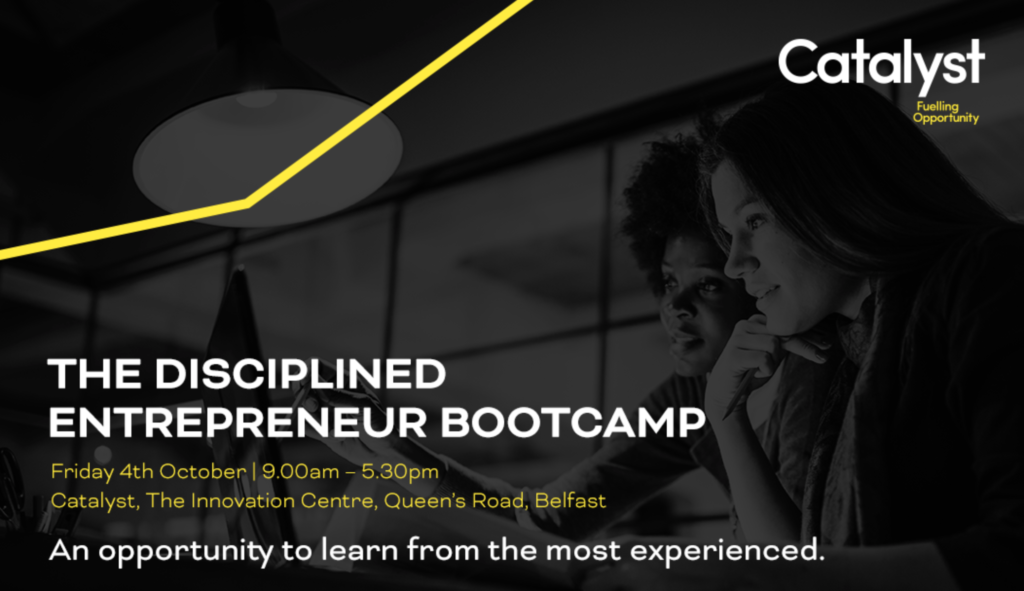
This one day workshop is an introduction to the basic concepts of Disciplined Entrepreneurship which will provide value to any entrepreneur or aspiring entrepreneur on its own. It is also an opportunity to gain exposure and an inside track on the many programs to help entrepreneurs in the Catalyst organization some of which can be seen here.
Agenda:
- 9:00 – 9:30 Registration
- 9:30 – 10:45 What Is Entrepreneurship and Why Should I take a disciplined approach?
- 10:45 – 11:00 Coffee
- 11:00 – 12:30 Disciplined Entrepreneurship in Action
- 12:30 – 1:30 Lunch
- 1:30 – 3:00 Who Is Your Customer?
- 3:00 – 3:15 Coffee
- 3:15 – 4:45 What Can You Do for Your Customer?
- 4:45 – 5:00 Summary of Day and Where Can You Go from Here?
- 5:00 – 5:30 Reception for Workshop participants
Time: 9:00 AM TO 5:30 PM
Cost: Tickets are complimentary however to maximise the experience and outcomes spaces are limited to 48!
This workshop is co-sponsored by QUB (Queens University Belfast), Belfast City Council and Invest Northern Ireland.
Sign up for our newsletter
The books
This methodology with 24 steps and 15 tactics was created at MIT to help you translate your technology or idea into innovative new products. The books were designed for first-time and repeat entrepreneurs so that they can build great ventures.


